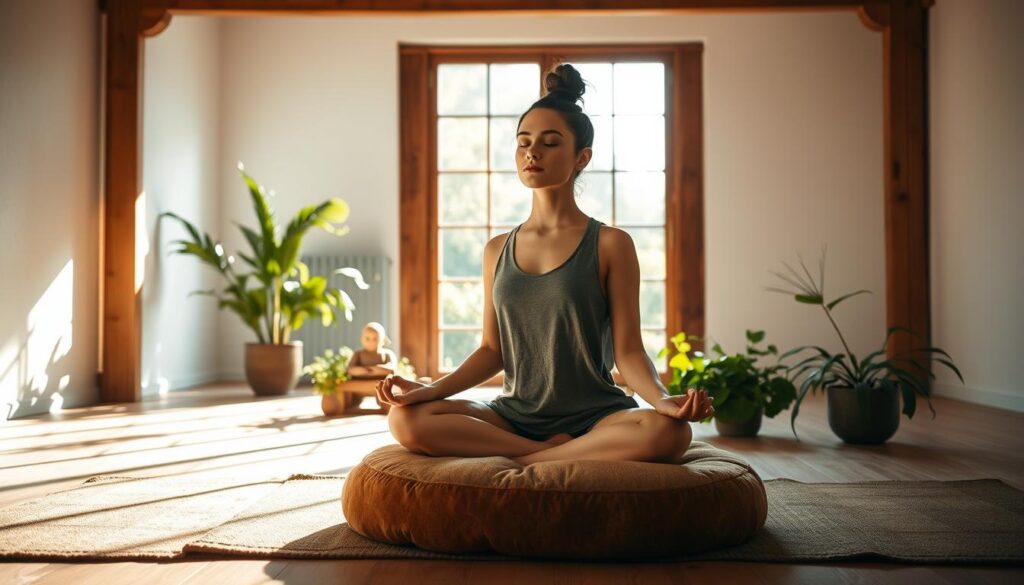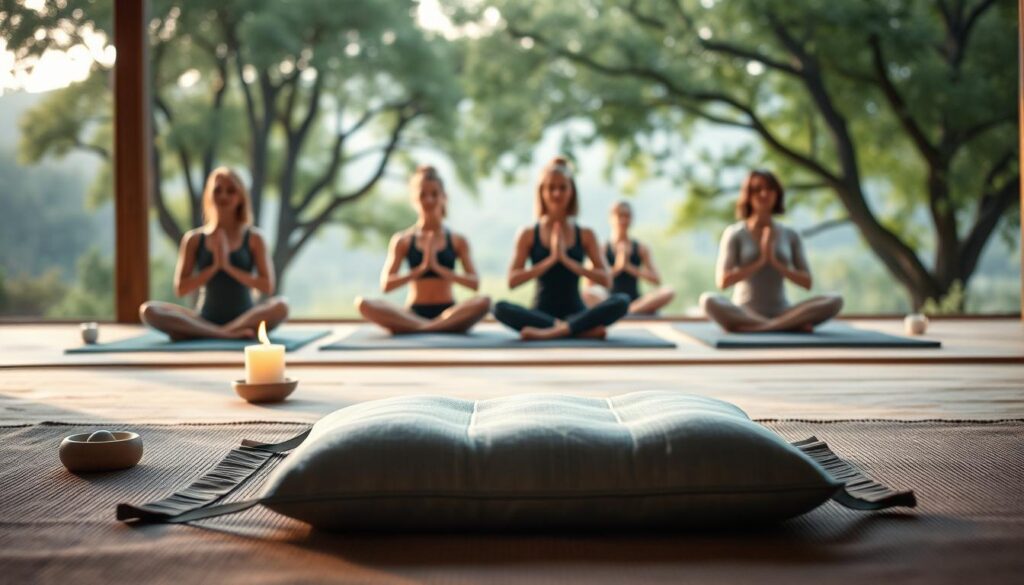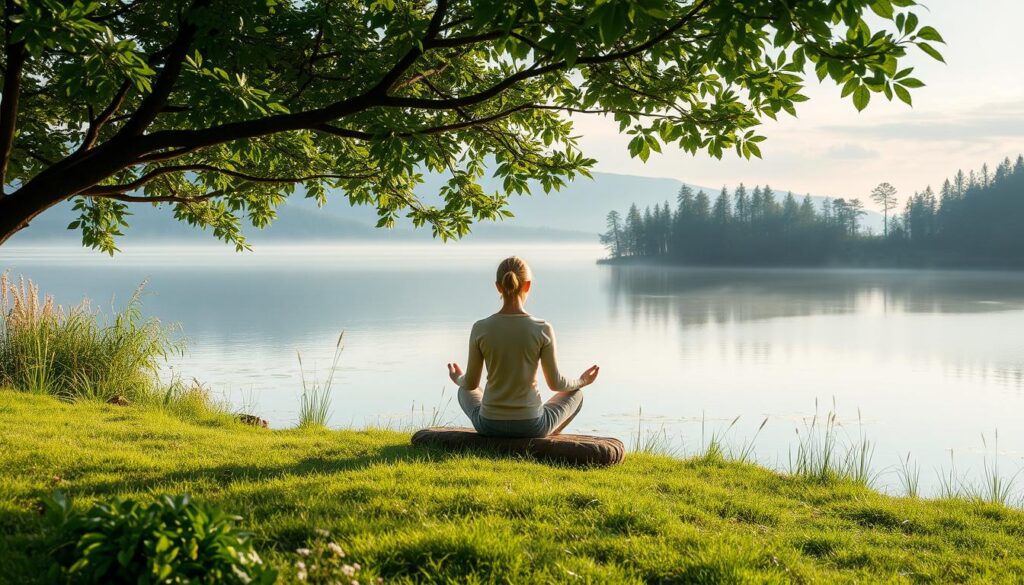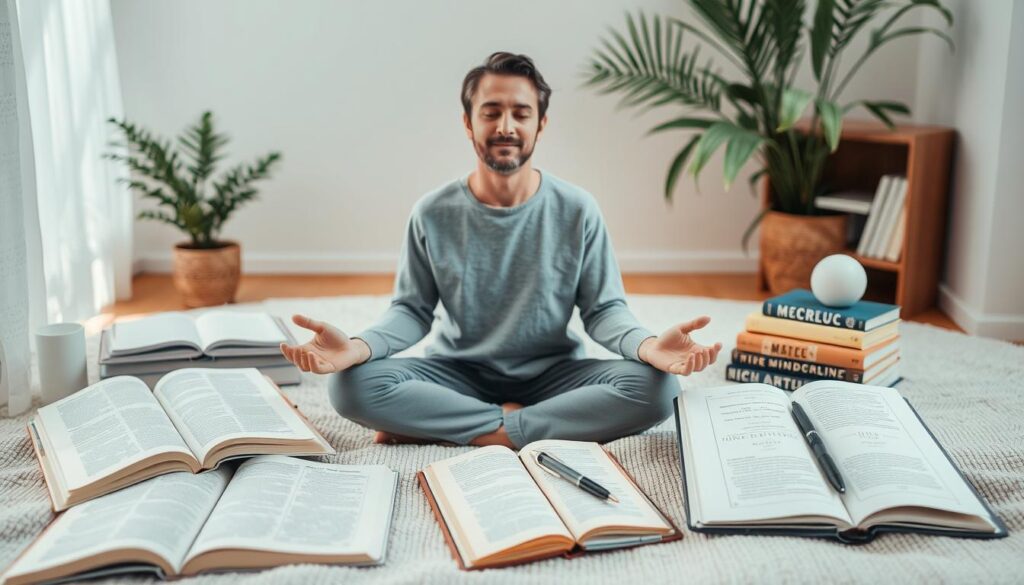I still remember the first time I started practicing meditation – it was a chaotic day, and I felt overwhelmed by my thoughts. As I began to focus on my moment-by-moment experience, I felt a sense of calmness that I had not experienced in a long time.
As I continued with my mindfulness practice, I realized that it wasn’t about emptying my mind completely, but rather about noticing my thoughts without judgment. I was intrigued by how this simple practice could bring so much clarity to my mind and improve my attention.
As it turns out, meditation is not just for those with special skills or spiritual beliefs – it’s a skill that anyone can develop with consistent practice. Even busy people can incorporate mindfulness into their daily routines, just a few minutes a day.
Key Takeaways
- Start with short meditation sessions to reduce stress and improve mental clarity
- Understand that meditation is not about emptying your mind, but about being aware of your thoughts
- Realize that meditation is a skill that can be developed with consistent practice
- Incorporate mindfulness into your daily routine, even if it’s just a few minutes a day
- Discover the practical benefits of meditation backed by science
Understanding Mindfulness Practice
As we dive into the world of mindfulness, it’s essential to understand its core principles. Mindfulness is more than just a practice; it’s a way of living that cultivates awareness and acceptance of the present moment.
What Is Mindfulness?
Mindfulness is the practice of paying attention to the present moment in a non-judgmental way. It’s about being fully engaged in whatever you’re doing, without getting caught up in thoughts or distractions. This practice helps develop a greater awareness of your thoughts, feelings, and bodily sensations.
Mindfulness vs. Mind Full: The Key Difference
The terms “mindfulness” and “mind full” are often confused with each other, but they have distinct meanings. Being “mind full” means being cluttered with thoughts and distractions, whereas mindfulness is about being aware and present. The key difference lies in the quality of attention: one is scattered, and the other is focused.
The Ancient Roots of Modern Mindfulness
Mindfulness has its roots in ancient Buddhist traditions, dating back over 2,500 years. The practice of mindfulness, or “sati” in Pali, was part of the Buddha’s Eightfold Path to end suffering. This wisdom has been passed down through generations and has evolved into the mindfulness practice we know today, adapted for modern life by pioneers like Jon Kabat-Zinn. Mindfulness practice has since been incorporated into various therapeutic approaches, including Mindfulness-Based Stress Reduction (MBSR) and Mindfulness-Based Cognitive Therapy (MBCT).
In today’s fast-paced world, mindfulness offers a powerful tool for reducing stress and increasing overall well-being. By understanding its roots and principles, we can better appreciate the wisdom that mindfulness has to offer.
The Science-Backed Benefits of Mindfulness
As we delve into the world of mindfulness, it becomes clear that this practice offers a multitude of benefits backed by science. Mindfulness has been shown to positively impact various aspects of our lives, from mental health to cognitive function.
Mental Health Benefits
Mindfulness practice has been linked to significant improvements in mental health. Regular mindfulness practitioners often experience reduced stress and anxiety, as well as improved mood. This is partly because mindfulness helps individuals develop a greater awareness of their thoughts and emotions, allowing them to manage them more effectively. By focusing on the present moment, individuals can break the cycle of negative thinking that often accompanies mental health issues.
Mindfulness and Emotional Regulation: One of the key ways mindfulness benefits mental health is by enhancing emotional regulation. By becoming more aware of their emotions, individuals can better manage their responses to challenging situations, leading to improved mental well-being.
Physical Health Improvements
The benefits of mindfulness extend beyond mental health to physical well-being. Studies have shown that regular mindfulness practice can lead to lower blood pressure, reduced chronic pain, and a stronger immune system. The reduction in stress that mindfulness provides is a significant factor in these physical health improvements, as chronic stress is known to have a negative impact on various bodily systems.
Mindfulness can also influence our health behaviors, such as eating habits and sleep patterns, by increasing our awareness of these aspects of our lives. This heightened awareness can lead to healthier choices, further contributing to overall physical health.
Cognitive Enhancement
Mindfulness has been shown to have a positive impact on cognitive functions such as attention and memory. By training the mind to focus on the present, mindfulness practice can improve attention span and reduce mind-wandering. Additionally, mindfulness has been linked to improvements in working memory capacity, which is crucial for problem-solving and learning.
The practice of mindfulness can also lead to changes in the brain structure, with increased gray matter in areas related to learning and memory. This neuroplasticity is a testament to the brain’s ability to adapt and change in response to mindfulness practice, potentially offering protection against cognitive decline and dementia.
The 7 Key Attitudes of Mindfulness
Mindfulness is more than just a meditation technique – it’s a way of living that encompasses seven core attitudes. These attitudes are the foundation upon which a meaningful mindfulness practice is built, influencing how we approach our daily life and interact with our thoughts and feelings.
Non-Judging and Patience
Non-judging involves observing our experiences without labeling them as good or bad. It’s about cultivating an open-minded approach to our thoughts and feelings. Patience, on the other hand, is about understanding that growth and change take time. It’s the ability to accept that things unfold at their own pace.
Together, non-judging and patience help us navigate life’s challenges with greater ease. By being more patient and less judgmental, we can reduce unnecessary stress and anxiety.
Beginner’s Mind and Trust
Having a beginner’s mind means approaching experiences with curiosity and openness, as if we’re experiencing them for the first time. Trust involves having faith in ourselves and our feelings, rather than doubting our inner wisdom. These attitudes work together to help us stay grounded in our mindfulness practice.
- Cultivate curiosity in daily activities
- Trust your instincts and inner guidance
Non-Striving, Acceptance, and Letting Go
Non-striving is about practicing mindfulness without trying to achieve a specific state or outcome. It’s embracing the present moment as it is. Acceptance involves acknowledging reality without resistance, rather than fighting against what cannot be changed. Letting go means releasing attachment to particular outcomes or expectations.
These three attitudes are interconnected. Non-striving allows us to be present without a specific agenda. Acceptance helps us acknowledge things as they are, and letting go frees us from attachment to specific outcomes. Together, they reduce suffering and increase peace of mind.
For example, when facing a difficult situation, we can apply these attitudes by being present without judgment, accepting the reality of the situation, and letting go of our attachment to a specific outcome. This can lead to a more peaceful and less stressful experience.
By incorporating these seven key attitudes into our practice, we can deepen our understanding of mindfulness and enhance our overall quality of life.
Getting Started: Your First Mindfulness Session
Starting your mindfulness journey can be as simple as dedicating a few minutes each day to the practice. As we explore how to begin, we’ll look at setting intentions, creating a dedicated space, and starting with a manageable 5-minute meditation practice.
Setting Your Intention
Before diving into your first mindfulness session, take a moment to define your intentions. What do you hope to achieve through mindfulness? Is it to reduce stress, improve focus, or simply feel more grounded? Clarifying your intentions can help you stay motivated and give direction to your practice.
Creating a Dedicated Space
Creating a dedicated space for your mindfulness practice can enhance your experience. It doesn’t have to be a large or elaborate space; even a small, quiet corner of your home can serve as a sanctuary for your mindfulness practice. Make this space inviting by adding elements that promote relaxation, such as a cushion or a plant.
Starting Small: The 5-Minute Practice
When starting your mindfulness journey, it’s crucial to begin small. A 5-minute practice is a great starting point. Here is a simple script you can follow:
- Sit comfortably with your back straight
- Close your eyes or keep them lightly closed
- Focus on your breath, noticing its rhythm
- When your mind wanders, gently bring your focus back to your breath
As you get more comfortable with the practice, you can gradually increase the duration. Consistency is key; even brief daily practices can make a significant difference in how you relate to your thoughts.
Let’s see how the duration of practice can impact your mindfulness journey:
| Practice Duration | Benefits |
|---|---|
| 5 minutes | Reduce stress, improve focus |
| 10 minutes | Enhance mental clarity, promote relaxation |
| 15 minutes | Deepen self-awareness, improve emotional regulation |
As you can see, even a short daily practice can be beneficial. The key is to be consistent and mindful of your intentions.

Foundational Mindfulness Techniques for Beginners
As we explore the realm of mindfulness, we find that certain foundational techniques can make all the deviation for those just starting out. These techniques serve as the building blocks for a strong mindfulness practice, helping you cultivate awareness, presence, and a deeper connection to your body and surroundings.
Let’s dive into some of these foundational techniques that are perfect for beginners.
Mindful Breathing
Mindful breathing is a fundamental technique that involves paying attention to your breath – the sensation of the air entering and leaving your nostrils, the rise and fall of your chest or abdomen. This simple yet powerful practice can be done anywhere, at any time. When you find your mind wandering, gently bring your attention back to your breath, focusing on the sensations it creates in your body.
To practice mindful breathing, find a comfortable seated position, close your eyes, and take slow, deliberate breaths. As you breathe in, notice the sensation of the air filling your lungs; as you breathe out, notice the sensation of the air leaving your body. If your mind starts to wander, gently bring it back to the sensation of your breath.
Body Scan Meditation
Body scan meditation is another foundational technique that helps you cultivate mindfulness by bringing awareness to different parts of your body. Lie down or sit comfortably, and bring your attention to different parts of your body, starting from your toes and moving up to the top of your head. As you focus on each area, notice any sensations, tension, or relaxation.
As you practice the body scan, you might find areas of tension or discomfort. Instead of trying to change them, simply observe them as they are. This practice helps you develop a deeper connection to your body and can help you release physical tension.
Mindful Walking
Mindful walking is a technique that turns an everyday activity into a meditation practice. It involves paying attention to the movements of your body as you walk, the sensation of your feet touching the ground, the rhythm of your steps. You can practice mindful walking anywhere – from a meditation hall to a busy city street.
To practice mindful walking, start by walking at a slow, deliberate pace. Pay attention to the sensation of your feet making contact with the ground, the roll of your feet from heel to toe, and the movements of your legs and body. As you walk, bring your attention to the present moment, letting go of thoughts and distractions.
Here are some key aspects to focus on when practicing mindful walking:
- Notice the sensation of your feet touching the ground
- Pay attention to the movements of your legs, hips, and body
- Keep your eyes forward, with a soft gaze
- Use the rhythm of your steps to anchor you in the present moment
As you get more comfortable with mindful walking, you can incorporate it into your daily activities, turning even the most mundane tasks into opportunities for mindfulness practice.
Mindfulness for Busy Professionals

In today’s fast-paced work environment, finding calm and clarity can seem like a challenge, but mindfulness can help. As professionals, we’re constantly juggling tasks, deadlines, and distractions, which can lead to increased stress levels and decreased productivity. By incorporating mindfulness techniques into our daily work routine, we can better manage workplace stress and improve our overall well-being.
Micro-Mindfulness Moments at Work
One of the simplest ways to bring mindfulness into your workday is through “micro-mindfulness” moments. These are brief, intentional pauses you take throughout the day to focus on your breath, notice your surroundings, or simply pay attention to the sensations in your body. By taking a few deep breaths or noticing the sensation of your feet on the ground, you can quickly reset your mind and reduce feelings of overwhelm.
Mindful Transitions Between Tasks
Another effective mindfulness technique for busy professionals is practicing mindful transitions between tasks. Instead of rushing from one task to the next, take a moment to pause, take a few deep breaths, and intentionally let go of the previous task. This helps to clear your mind and improve focus on the task at hand, enhancing your productivity and reducing mental clutter.
Using Mindfulness to Improve Focus
Mindfulness training directly strengthens the attention muscles needed for sustained focus. By regularly practicing mindfulness, you can improve your ability to concentrate and stay on task, even in the face of distractions. This is particularly useful in today’s work environment, where digital distractions are plentiful. Mindfulness helps you recognize when your mind has wandered and gently brings it back to the task, improving overall productivity.
5 Simple Mindfulness Practices for Daily Life
Mindfulness isn’t just for meditation; it’s a practice that can be woven into the fabric of our daily activities. By incorporating mindfulness into our daily routines, we can cultivate a greater sense of awareness and calm, making it easier to navigate life’s challenges.
Mindful Wakeup Routine
Starting your day with a mindful wakeup routine can set a positive tone. Take a few deep breaths, notice the sensation of your feet touching the bed, and slowly begin your morning. This mindful moment can help you start the day with clarity and attention to your intentions.
Mindful Eating
Mindful eating involves savoring each bite, paying attention to the flavors, textures, and aromas of your food. This practice can transform meals into a more enjoyable and satisfying experience, encouraging a healthier relationship with food.
Mindful Pause
Throughout the day, take short mindfulness breaks, or “mindful pauses,” to breathe, stretch, or simply notice your surroundings. These pauses can help reduce stress and increase productivity.
Mindful Movement
Engage in physical activities like yoga or walking with a mindful attitude. Pay attention to the sensations in your body, the rhythm of your breath, and the surroundings. This mindfulness activity can enhance your connection to your body and environment.
Mindful Commuting
Commuting can be a significant source of stress, but it can also be an opportunity for mindfulness. Whether driving, using public transit, or walking, you can practice mindfulness by paying attention to your breath, the sensations in your body, or the environment around you. For drivers, this might mean being more aware of the road and other drivers, enhancing safety. For those using public transit, it could involve noticing the people around you or the rhythm of the journey. Walkers can pay attention to their footsteps, the surroundings, or the sensation of the air on their skin. By transforming commuting time into a mindful moment, you can reduce stress and arrive at your destination more present and prepared for the day ahead.
By incorporating these simple mindfulness activities into your daily life, you can cultivate a greater sense of awareness, reduce stress, and enhance your overall well-being.

Overcoming Common Mindfulness Challenges
Embracing mindfulness can be a transformative experience, but it’s not without its challenges. As we cultivate our mindfulness practice, we may encounter some common obstacles that can make it difficult to stay on track.
Dealing with a Wandering Mind
One of the most common challenges is dealing with a wandering mind. Our minds can easily get distracted by thoughts, emotions, and external stimuli. To overcome this, we can use simple techniques like focusing on our breath or using a meditation anchor to gently bring our attention back to the present moment.
Finding Time in a Busy Schedule
Another challenge is finding time to practice mindfulness in our busy schedules. We can overcome this by incorporating micro-mindfulness moments into our daily routine, such as taking a few deep breaths while commuting or during breaks at work.
Staying Consistent with Your Practice
Staying consistent with our mindfulness practice can be challenging, but there are several strategies that can help. We can use habit stacking by connecting our meditation practice to existing habits, like practicing right after waking up or before a daily workout. We can also track our practice to increase motivation and accountability. Moreover, being compassionate with ourselves when we miss a day and adapting our practice during challenging periods can help us stay on track.
Some key strategies to maintain consistency include:
- Using habit stacking to connect meditation to existing habits
- Tracking your practice to increase motivation and accountability
- Being self-compassionate when you miss a day
- Adapting your practice during challenging periods like illness or travel
Mindfulness for Anxiety and Stress Reduction

Anxiety and stress can feel overwhelming, but mindfulness offers a powerful toolkit to manage these feelings. By incorporating mindfulness into your daily routine, you can develop a greater sense of calm and resilience.
Recognizing Stress Patterns
The first step in managing stress and anxiety is recognizing the patterns that lead to these feelings. Mindfulness helps you become more aware of your thoughts, emotions, and physical sensations, allowing you to identify triggers and respond more effectively.
By paying attention to your body and mind, you can start to notice the early warning signs of stress and anxiety, such as tension in your shoulders or a racing mind.
Grounding Techniques
Grounding techniques are a powerful way to bring your focus back to the present moment, reducing feelings of anxiety and stress. One simple method is to focus on your five senses: notice the sensation of your feet on the ground, the sounds around you, or the sensation of the air on your skin.
These techniques help distract you from worrisome thoughts and anchor you in the present, providing immediate relief from anxiety and stress.
Progressive Muscle Relaxation
Progressive muscle relaxation is a technique that combines mindfulness with physical relaxation. By systematically tensing and relaxing different muscle groups in your body, you can release physical tension and reduce mental stress.
To practice, start by tensing your toes, holding for a few seconds, and then releasing. Move up through your body, tensing and relaxing each muscle group in turn. This practice not only relaxes your body but also increases your awareness of physical tension, helping you to manage stress more effectively.
Regular mindfulness practice, including techniques like progressive muscle relaxation, can significantly reduce anxiety and stress by teaching you to recognize and release tension in your body. As you become more attuned to your physical and emotional state, you’ll be better equipped to handle life’s challenges with calm and clarity.
Advanced Mindfulness Meditation Techniques
Delving into advanced mindfulness meditation techniques can significantly enhance your mental clarity and emotional resilience. As you continue on your mindfulness journey, exploring these sophisticated practices can lead to profound insights and a deeper understanding of yourself.
Advanced mindfulness techniques are designed to build upon the foundational practices, offering a more nuanced approach to cultivating mindfulness. Some of these techniques include:
- Loving-kindness meditation, which focuses on cultivating compassion and empathy towards oneself and others.
- Visualization practices, which involve creating vivid mental images to promote relaxation and inner peace.
- Insight meditation (vipassana), a practice that involves clear seeing into the nature of experience, helping develop wisdom about impermanence, unsatisfactoriness, and non-self.
Loving-Kindness Meditation
Loving-kindness meditation is a powerful technique that cultivates feelings of love, compassion, and kindness towards oneself and others. By practicing loving-kindness meditation, you can enhance your emotional well-being and develop a more positive outlook on life.
Visualization Practices
Visualization involves creating vivid mental images to promote relaxation, focus, and inner peace. This technique can be particularly helpful for reducing stress and anxiety. To practice visualization, find a quiet space, close your eyes, and imagine yourself in a peaceful environment. You can also use guided visualization recordings, like those found in advanced meditation resources, to help you get started.
Insight Meditation
Insight meditation, or vipassana, is a practice that involves observing your thoughts, feelings, and bodily sensations with clarity and precision. This technique helps you develop a deeper understanding of the impermanent and ephemeral nature of your experiences. By practicing insight meditation, you can gain valuable insights into the nature of reality and cultivate a greater sense of wisdom and compassion.
To begin an insight meditation practice, start by focusing on your breath or bodily sensations. As you progress, you can expand your awareness to include thoughts and emotions, observing them without judgment. It’s essential to approach this practice with patience and consistency, as it can lead to profound shifts in how you relate to your experience.
For those interested in deepening their insight meditation practice, it’s crucial to seek guidance from experienced teachers or resources. This will help you navigate any challenges and ensure a fruitful practice.
Integrating Mindfulness into Your Lifestyle
Integrating mindfulness into our lifestyle can lead to profound changes in how we experience life. It’s about making mindfulness a part of our daily activities, not just a separate practice. By doing so, we can cultivate a more mindful and fulfilling life.
Making Mindfulness a Habit
Creating mindful habits is the first step towards integrating mindfulness into our lifestyle. This involves incorporating mindfulness activities into our daily routine, such as mindful breathing or body scan meditation, to increase our awareness and attention to the present moment.
Communicating Mindfully
Mindful communication is about being fully present in our interactions with others. It involves listening attentively, speaking clearly, and being aware of our non-verbal cues. By practicing mindful communication, we can improve our relationships and reduce misunderstandings.
Embracing Digital Mindfulness
In today’s digital age, our devices can be both a source of distraction and a tool for mindfulness. Practicing digital mindfulness involves being intentional about our technology use, setting boundaries, and using our devices in a way that supports our well-being.
| Mindfulness Practice | Daily Life Application | Benefit |
|---|---|---|
| Mindful Breathing | Before meetings or stressful situations | Reduces anxiety and improves focus |
| Mindful Communication | In conversations with family and colleagues | Enhances understanding and empathy |
| Digital Mindfulness | During device use | Promotes healthy technology habits |
By integrating mindfulness into our lifestyle, we can experience a more balanced and fulfilling life. It’s a journey that requires patience, consistency, and self-compassion, but the benefits are well worth the effort.
Mindfulness-Based Therapeutic Approaches
As we explore the vast landscape of mindfulness, we find that it has evolved into various therapeutic approaches. These approaches have been developed to help individuals deal with various mental health issues, including stress, anxiety, and depression.
Mindfulness-Based Stress Reduction (MBSR)
Mindfulness-Based Stress Reduction is an eight-week program that was developed by Jon Kabat-Zinn. It is designed to help individuals manage stress and anxiety by using mindfulness techniques such as meditation and deep breathing. Studies have shown that MBSR can help reduce stress and anxiety in individuals, improving their overall mental health.
Mindfulness-Based Cognitive Therapy (MBCT)
Mindfulness-Based Cognitive Therapy is another approach that combines elements of cognitive-behavioral therapy with mindfulness practices. It is designed to help individuals who suffer from depression and anxiety. MBCT helps individuals become more aware of their thoughts and feelings, allowing them to manage their mental health more effectively.
When to Seek Professional Guidance
While mindfulness can be practiced by anyone, there are certain situations where professional guidance is recommended. For instance, if you are dealing with trauma or clinical conditions, it is essential to find a qualified teacher or therapist who can guide you through the process. Some red flags to watch out for when seeking a mindfulness teacher or program include lack of proper training, unqualified instructors, or programs that seem too good to be true.
When looking for a mindfulness-informed therapist or program, you can start by asking for referrals from your healthcare provider or checking online directories. It is also essential to research the therapist’s or program’s credentials and read reviews from other clients.
Here is a simple table to help you understand the differences between MBSR and MBCT:
| Program | Main Focus | Duration |
|---|---|---|
| MBSR | Stress reduction | 8 weeks |
| MBCT | Cognitive therapy | 8 weeks |
Resources to Deepen Your Mindfulness Practice
As you grow in your mindfulness practice, you’ll find that there are many resources available to help you continue to grow. Whether you’re looking for guided meditations, insightful reading material, or supportive communities, there are numerous ways to deepen your practice and enhance your overall well-being.

Recommended Books and Apps
Some popular mindfulness resources include books like “The Miracle of Mindfulness” by Thich Nhat Hanh and “Wherever You Go, There You Are” by Jon Kabat-Zinn. For digital resources, apps like Headspace and Calm offer guided meditations and mindfulness exercises.
Online Courses and Communities
Online courses, such as those found on Coursera or Udemy, can provide in-depth learning experiences. Joining mindfulness communities, either online or in-person, can also provide valuable support and accountability.
Conclusion: Embracing the Mindful Journey
As we come to the end of our journey exploring mindfulness, it’s clear that this practice is more than just a technique – it’s a way of life. Throughout this article, we’ve explored the various facets of mindfulness, from its definition and benefits to practical techniques for incorporating it into our daily lives.
We’ve seen how mindfulness can be a powerful tool for reducing stress and anxiety, improving our mental and physical health, and enhancing our cognitive abilities. We’ve also discussed how to overcome common challenges and integrate mindfulness into our lifestyle.
The key points covered in this article emphasize that mindfulness is a lifelong journey rather than a destination. It’s a journey that has its ups and downs, but it’s through consistent practice that we can experience its transformative effects. It’s about making progress, not achieving perfection.
As we move forward, let’s remember to start with small, consistent steps. Let’s be kind to ourselves as we navigate the process, acknowledging that it’s okay to have moments of struggle. As we practice mindfulness in our daily lives, we will begin to notice a gradual transformation in our relationship with ourselves and the world around us.
For instance, I have found that incorporating mindfulness into my daily routine has helped me stay grounded and focused, even in the midst of chaos. It has been a moment-by-moment journey, and one that I am grateful for. As we conclude, I invite you to take your first step or continue on your mindfulness journey, starting with one mindful breath – because the journey starts in this moment, in this life.
FAQ
What is the best way to start a meditation session?
To start, find a quiet and comfortable spot, sit with your back straight, and focus on your breath – gently bringing your attention back when your mind wanders.
How can I make meditation a habit?
Begin with a manageable daily commitment, like 5 minutes, and gradually increase the duration as you become more comfortable with the meditation process.
What are some common challenges people face when starting a meditation routine?
Many struggle with a wandering mind or finding the time; being patient and starting small can help overcome these hurdles.
Can meditation help with anxiety and stress?
Yes, meditation and breathing exercises can help reduce stress and anxiety by promoting relaxation and teaching you to stay present.
How does being mindful differ from being mind full?
Being mindful means being fully engaged in the current moment, while being mind full implies being preoccupied with thoughts, often negatively.
What are some simple ways to incorporate mindfulness into daily activities?
You can pay attention to your senses during routine tasks like eating or walking, or take short breaks to focus on your breath and surroundings.
Are there any mindfulness techniques for improving focus and productivity?
Yes, mindful transitions between tasks and taking short mindfulness breaks can help improve concentration and overall work quality.
How can I stay consistent with my mindfulness and meditation routine?
Creating a dedicated space, setting reminders, and starting with achievable goals can help maintain consistency in your mindfulness practices.
What are some recommended resources for deepening my understanding of mindfulness?
You can explore various books, apps, online courses, and communities that offer guided meditations and mindfulness exercises.
Can mindfulness be used in conjunction with other therapeutic approaches?
Yes, mindfulness-based stress reduction (MBSR) and mindfulness-based cognitive therapy (MBCT) are examples of therapies that integrate mindfulness into their methodologies.
